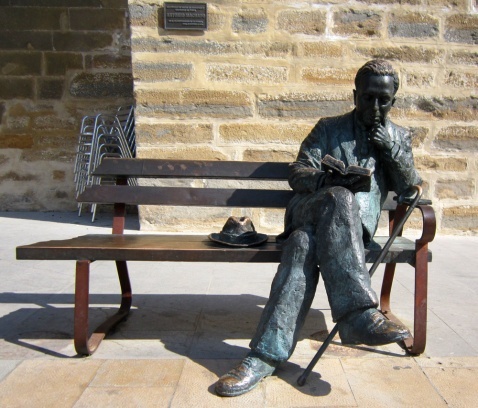
Antonio Machado statue in Baeza © Andrew Edwards |
|
| Paseo Antonio Machado in Baeza © Andrew Edwards |
|
Antonio Machado, Poet (1875 - 1939)
by Andrew and Suzanne Edwards
The poet Antonio Machado is one of the most respected authors to come from the 20th century world of Spanish letters. He was greatly admired by the famous Generation of '27, especially by the young Federico García Lorca who went to visit him in Baeza. Although Machado's most well-known work is The Castilian Country (Campos de Castilla), he is forever linked with this northern Andalucian city; which, along with Úbeda, has achieved World Heritage Status for its beautiful Renaissance architecture.
Born in Seville, Antonio moved to Baeza in Jaén Province after the death of his young wife from tuberculosis. He came south from Soria, where he had been working as a French teacher; the day job that enabled him to pen his verses free from financial worries. It was a grief-stricken Machado who found himself walking the streets of his new city, the only consolations his new teaching post and the success of Campos de Castilla. Indeed, it was this success that stopped him from seriously contemplating suicide. He noted to a friend that this preventative pride had nothing to do with vanity, but the fact that his works could prove of some use and merit.
As the chilly winter progressed in this interior city, Antonio continued to write verse that lamented the loss of his wife, poetry that he decided to include in the second reprinting of his Castilian book. John Dos Passos, the American who reported on the Civil War, referred to his poems as 'verse taken up with place. It is obsessed with the old Spanish towns where he has lived, with the mellow sadness of tortuous streets and of old houses that have soaked up the lives of generations'. To that we could add the sadness of a love stolen from him at such a young age.
There are many traces of Machado in Baeza and perhaps the best place to start is the street that leads from the Jaén Gate at the south western end of the central Paseo de la Constitution. The street has been rechristened the Paseo Antonio Machado in his honour, and skirts the city walls until it broadens out on to more open land at the very edge of the urban area. Antonio used to carry on walking into the olive lined countryside, lost in his thoughts. It was the kind of landscape he immortalised in 'The Olive Tree': 'Parched old olive trees / standing full in the sun, / powdery with dust / from the Andalucian earth...' Retracing our steps to the centre of town, the Spanish original of this verse is found on a bronze plaque in the garden of the Jabalquinto Palace.
The Jabalquinto epitomises the kind of building that gave Baeza World Heritage status. Its façade appears jewel encrusted, when the strident sun hits the ochre stone frontage at the right angle to accentuate the diamond-shaped embellishments under the loggia. Once an aristocratic residence, it is now the Baezan seat of the Universidad Internacional de Andalucía and inevitably named after Machado.
Opposite the Jabalquinto is a building which, conversely, was once a university, reverting to a school in the late 19th century. To the right of the door, there is another plaque commemorating our poet. This was the building that housed the school employing Antonio. The interior has a cloistered atmosphere, with the ground floor sporting a porticoed courtyard. One of the rooms leading from the courtyard was Machado's classroom and has been preserved as such. There are rows of traditional school benches, complete with original graffiti and a raised teacher's table. The centre has a glass cabinet full of Machadiana - letters, newspaper articles and documents. A portrait of the perpetually balding poet surveys the missing students.
In truth, Antonio was not a natural teacher who thought of the job as a vocation. Teaching was a means to an end, a way of continuing to write, whilst maintaining an honourable profession. However, he did make an effort to apply the standards he learnt at the Institución Libre de Enseñanza, trying to impart an education free from dogma and politico-religious influence. Clearly, Machado had a liberal frame of mind and it is no surprise that he supported the Republicans during the war.
During the Civil War, he worked assiduously to promote the Republican cause, penning many tracts and articles in an attempt to bolster the war effort. Eventually, he had to move with the fading government in order to avoid the advancing Nationalists, ending up in a besieged Barcelona. His heartbreak was compounded by the fact that his poet brother was writing propaganda for the opposing forces. The only remaining option was to escape into exile over the French border, via the Pyrenees and Port Bou. It was an exhausted Machado who finally made it to Collioure, the French town where he is now buried. He died at the age of 63 just weeks after making the crossing, being outlived by his aged mother who passed away shortly afterwards.
The most poignant of all Baezan memorials to Machado can be found in Calle San Pablo, a pedestrianised street leading from the central square. Antonio sits to one side of a bench, cross-legged, contemplating the pages of an open book he holds before him. His hat and cane are carefully placed to one side, ready to be picked up should he decide to stroll off into the surrounding countryside.
Andrew and Suzanne Edwards have written Andalucia - A Literary Guide for Travellers, published in September 2016 by I. B.Tauris. It may be purchased online directly from the publishers, Andalucia: A Literary Guide for Travellers and Amazon. This compliments their previous work, Sicily: A Literary Guide for Travellers (Literary Guides for Travellers)